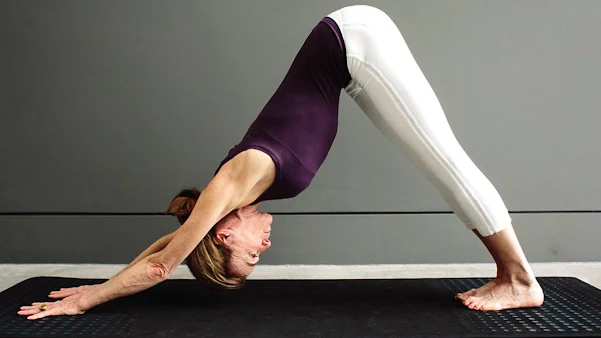Downward-Facing Dog: A Comprehensive Guide to Adho Mukha Svanasana for Strength and Flexibility+
Downward-Facing Dog, also known as Adho Mukha Svanasana, is a widely practiced yoga pose that offers numerous benefits for the body and mind. In this comprehensive description, I will provide you with an extensive explanation of Downward-Facing Dog, including alignment, modifications, variations, benefits, and more.
Alignment and Key Elements of Downward-Facing Dog:
- Begin on your hands and knees, aligning your wrists directly under your shoulders and your knees under your hips. Spread your fingers wide apart, with the middle fingers pointing forward.
- Tuck your toes under and lift your knees off the ground, straightening your legs while keeping a slight bend in the knees if needed. Your body will form an inverted V shape.
- Engage your core muscles by drawing your navel toward your spine. Lengthen your tailbone away from your lower back, creating space and length in your spine.
- Press your hands firmly into the ground, distributing the weight evenly across your palms and fingers. Straighten your arms, externally rotating your upper arms and broadening your collarbones.
- Activate your leg muscles by pressing your heels toward the floor. If your hamstrings are tight, it's okay to keep a slight bend in your knees or raise your heels slightly off the ground.
- Allow your head to hang freely between your arms, relaxing your neck. Gaze toward your navel or between your legs, depending on your comfort level and flexibility. Ensure your neck is in line with your spine.
- In this pose, actively engage your entire body. Firm your shoulder blades against your back, lengthen your side body, and draw your inner thighs upward.
- Take deep, slow breaths, allowing your breath to flow smoothly. Feel the stretch in the back of your body, from your fingertips through your arms, spine, and legs.
- Hold the pose for several breaths, gradually increasing your capacity over time. Aim to stay in the pose for 1-3 minutes, or as long as feels comfortable for you.
- If you have wrist discomfort, you can try using yoga blocks or wedge-shaped props under your hands to alleviate pressure.
- To make the pose more accessible, you can practice with your knees bent, focusing on the elongation of the spine and the stretch through the back of the body.
- If you have tight calves, you can place a rolled-up towel or blanket under your heels to support them.
- If you have shoulder issues, you can practice the pose with your hands on a wall, maintaining the alignment and shape of the pose while reducing the weight-bearing aspect on the shoulders.
- Stretches and strengthens: Downward-Facing Dog stretches and strengthens the shoulders, hamstrings, calves, arches of the feet, and the entire back body.
- Improves posture: Regular practice of this pose helps lengthen the spine, counteracting the effects of prolonged sitting and promoting good posture.
- Enhances circulation: The inverted nature of the pose encourages blood flow to the brain, improving circulation throughout the body and providing a fresh supply of oxygen.
- Builds upper body strength: Holding your body weight with your arms and shoulders in this pose helps develop upper body strength and stability.
- Relieves stress and calms the mind: The gentle inversion and conscious breathing in Downward-Facing Dog can help reduce stress, anxiety, and fatigue while promoting a sense of calm and relaxation.
- Improves digestion: The gentle compression of the abdomen in this pose can stimulate digestion and relieve digestive discomfort.
- Energizes the body: Practicing Downward-Facing Dog can help invigorate and energize the body, making
As with any yoga pose, it's important to listen to your body and modify the pose as needed. If you have any specific concerns or conditions, it's advisable to consult with a qualified yoga instructor or healthcare professional before practicing. Enjoy the benefits of Downward-Facing Dog as you explore this rejuvenating pose in your yoga practice.




.jpg)
.jpg)

